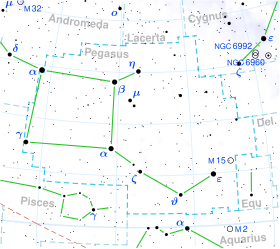Top Qs
Timeline
Chat
Perspective
Pi1 Pegasi
Star in the constellation Pegasus From Wikipedia, the free encyclopedia
Remove ads
Pi1 Pegasi, Latinized from π1 Pegasi, is a star in the constellation Pegasus. Based upon changes to the proper motion of the visible component, this is a probable astrometric binary.[8] It has a yellow hue and is dimply visible to the naked eye with a combined apparent visual magnitude of +5.58.[2] The system is located approximately 319 light years distant from the Sun based on parallax,[1] and is drifting further away with a radial velocity of +5 km/s.[4]

The visible component is an aging giant star with a stellar classification of G8IIIb.[3] With the supply of hydrogen exhausted at its core, the star has cooled and expanded to 11 times the Sun's radius[1]. It is radiating 63 times the luminosity of the Sun from its enlarged photosphere at an effective temperature of 4,898 K.[1]
Remove ads
References
External links
Wikiwand - on
Seamless Wikipedia browsing. On steroids.
Remove ads

